|
18th June 2015, Alyn Waters Country Park
A return visit here primarily for the Bee Orchids, and hoping beyond hope, that a variant or two could be spotted. The whole park was dry as a bone, and the first Bee Orchid spot, close to the car park, has fewer in flower this year. However the other areas had plenty to see, and we even found two new spots where they grow. Looking at the photos taken I can see quite a range of sizes for the petals, which has not been apparent to me before. Checking back on photos from other Bee Orchid sites this variation is not unusual. Below are examples of long, short, stout and almost sepal-like.
There was no sign of the D.fuchsii var rhodochila again this year (has it been pilfered?), and neither the Southern Marsh Orchid I had been given directions too
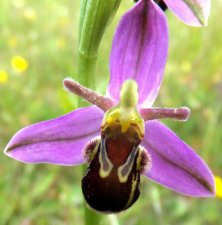 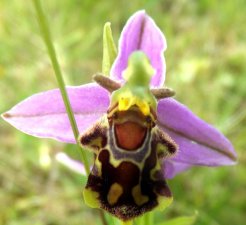 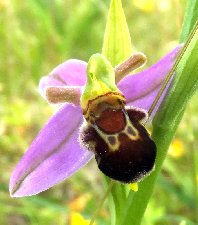 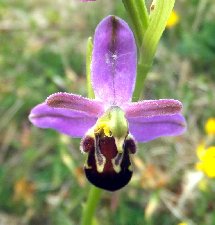
19th June 2015, Buckley Common
It has been two years since my last visit. The site seems a bit more overgrown than previously, both roadside and the actual common itself. This made it look as if the orchid show was poor this year at first glance, but while some patches did seem to have fewer orchids in flower, others were as prolific as in previous years. The ground was noticeably drier than normal and this may be a factor. With orchids flowering a tad later in 2015 I hoped to catch the Northern Marsh Orchids (which were on their way out on previous visits) and was not disappointed. The hybridisation between these and the Common Spotted still dominates, but there is still a significant number of NMOs. One find was a Southern Marsh Orchid, and while these have not been seen here in the last few years, this vindicates my notes from way back in 1979 where I mentioned their presence. Perhaps these have been largely hybdridised out. However the obvious hybrids all seem to be D. x venusta with spotted leaves and pointed central lobe of the CSO parent, and the colour and bold labellum markings of the NMO.
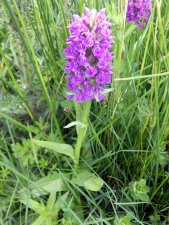 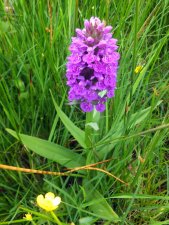 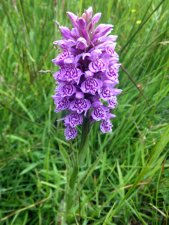 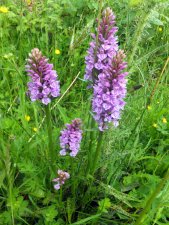
Northern Marsh Orchids x venusta hybrids
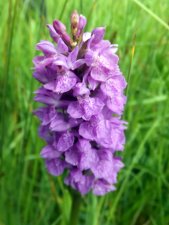
Southern Marsh Orchid
19th June 2015, RSPB Conwy
This birding reserve was created using the mud and silt that was excavated from under the Conwy estuary when the A55 tunnel was dug. Hence it has parallels with Samphire Hoe. The orchids here are therefore recent colonisers. The Bee Orchids are by far the most widespread being found close to the buildings or facing the estuary. The Dactylorhizas prefer one largish area on the northern side. The Southern Marsh Orchids are quite numerous and make a fine display, with some variation in both colour and size. There were patches where all plants were the same shade and flower shape, adjacent to another patch all of another colour and form. Early Marsh var coccinia also occurs, and though rather stunted they show up due to their very deep intense colouration.
It's not just orchids here. Cop a look at the birds too. We were treated to the sight of a pair of Little Egrets, as well as more predictable visitors to the reserve.
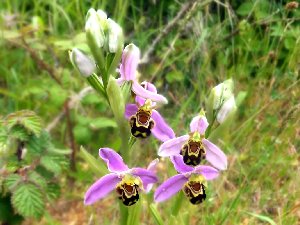 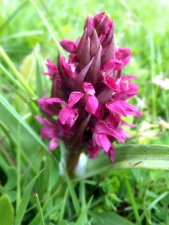 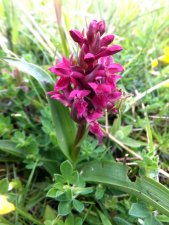
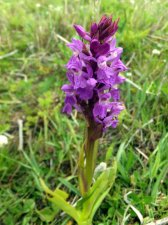 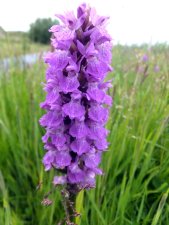 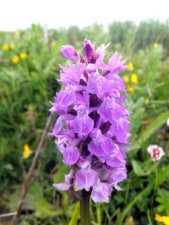 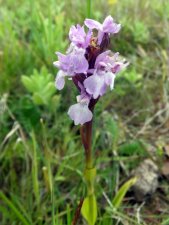
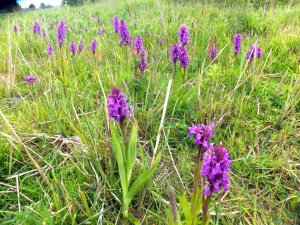 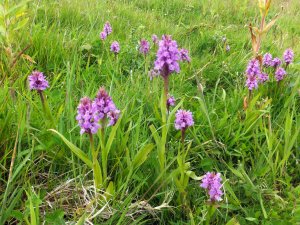
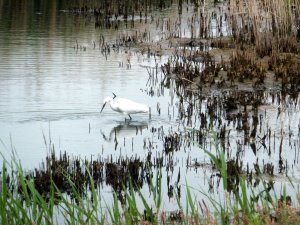
19th June 2015, A55 Abergele
En-route to Conwy we diverted through Abergele and at roundabout off the main road was a group of Pyramidal Orchids, the first time I have seen this as a road verge orchid. This is tempered against the new policy of cutting the flora alongside the main roads in June. Several colonies of Common Spotted Orchids have been hacked down by mowers. It's not just the orchids that are destroyed; all the annuals that grow there are destroyed before they have a chance to re-seed for next year. A plague of boils on those in the council highways departments who make these decisions.
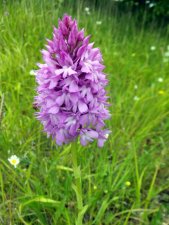
20th June 2015, Wrexham Industrial Estate
Looking back at Bee Orchid photos taken here in 2014 I found one that seemed to suggest it was var belgarum. Hoping to locate it for a better photo we were surprised to see that the land behind the grass verge is the site for the new penal colony. The verge had been untended earlier in the season and was weed infested. Will it be restored? Perhaps, but once the prison is opened anyone crawling around in the grass, camera in hand, just outside the walls will set alarm bells ringing - literally. But for this year there were a couple of Bee Orchids that did have a bit of belgarum about the labellum markings lack of speculum and vertical yellow lines), but retained the big hairy side bumps that mark the normal form.
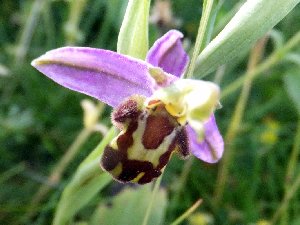
26th June 2015, Kenfig Burrows
It has been 32 years since I my last and only visit here. My old records mention just Southern Marsh and Early Purple Orchids, but in all honesty, we didn't venture far in or stay long. Kenfig has claims of Epipactis variations such as E. helleborine neerlandica, E helleborine `youngiana' and E. phylanthes cambriensis; all disputed forms. We were too early for any of these, and didn't have any idea where to start looking for them. Instead we had two good leads as to where to look for the Fen Orchids, and this is the ideal time. Unfortunately this wasn't the best day for a walk across the dunes as it was raining steadily; this is reflected in many of the photographs and led to a greater percentage being rejected than usual.
The Fen Orchids are the stars of these dunes. It wasn't difficult to find the dune slack (or at least one of the slacks) where it grows, and only a bit more difficult to locate it as it is quite a large area to cover. There are plenty of other orchids there; enough to distract. We found them growing in two areas, and once seen it became reasonably easy to spot more. There were 14 in flower, and a similar number of younger plants. Photography proven difficult. Rain didn't help, and short, pale flowers without a decent inflorescence makes focussing difficult
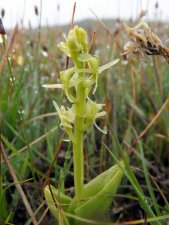 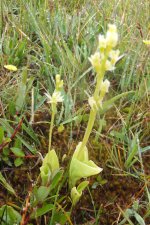 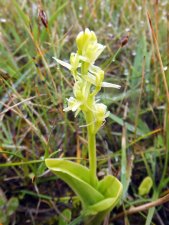 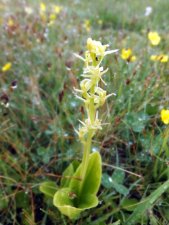 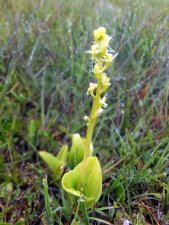 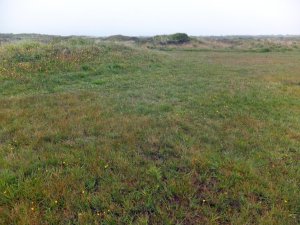
The part of the slack where Fen Orchids found. Click to enlarge and spot them!
The Early Marsh Orchids grow in the same dune slack and are represented by ssp coccinea, ssp incarnata and var leucantha. The reserve's on-line blog mentions the presence of ssp ochroleuca, but this only grows in one Norfolk fen and must be due to confusion with var leucantha. Even these may be a red herring, for there are pale ssp incarnata plants which show the pink colour at first, which gradually fades to white, however I do think the example pictured is the real deal.
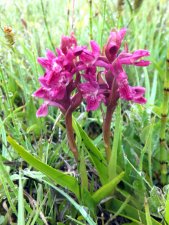 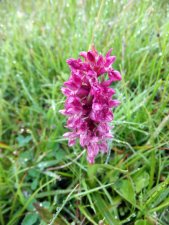 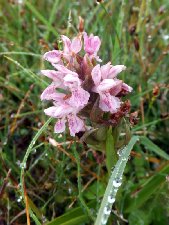
ssp coccinea ssp incarnata
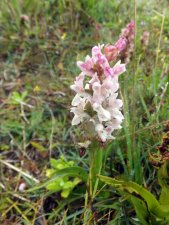 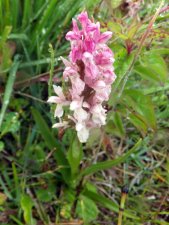 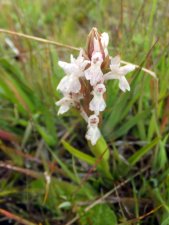 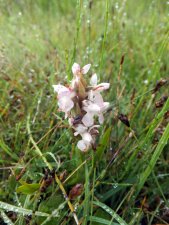
incarnata fading to white var leucantha
The Southern Marsh Orchids are quite widespread, present from the near the reserve buildings right into the dunes. These gave me a bit of a problem, as I usually see these as being rather wishy-washy in colouration with only flecks of darker colouration on the lip. This population is generally quite purple with a marker variation, and in having deeper coloured lines; some even having patterns and the magenta colour of Northern Marsh Orchids. Only the labellum shape and the overall form of the plant revealed them to be Southern Marsh.
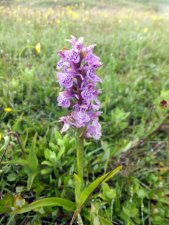 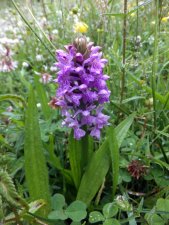 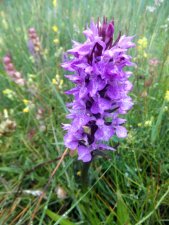 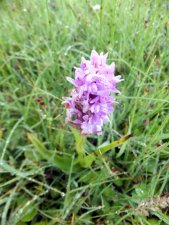 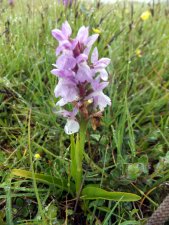
The other Dactylorhiza present were a bit problematic - surprise surprise. There is a good chance of hybrids when two or more species grow in the same area, but these show a range of characteristics without looking half way between two pure-bred parents. The fifth image below shows a Common Spotted Orchid with lip markings that look smeared evenly with a pale border. To me the second image show a hybrid with elements of the Southern Marsh and the Early Marsh Orchid, and could be classified as Dactylorhiza x wintonii.
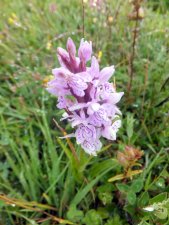 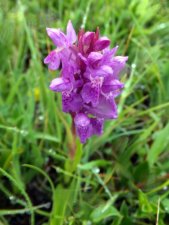 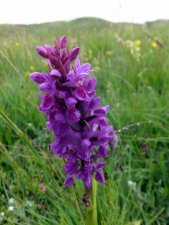 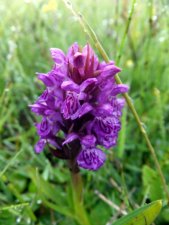 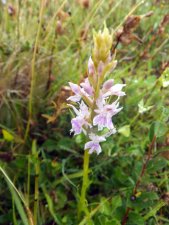
The Marsh Helleborines were beginning to flower in the dune slack. Of note were a few that were very pallid and lacking any reddish colour. They hadn't opened but are most likely var leucantha. Unfortunately this is the best picture, but it does show a normal plant and a pale one side by side.
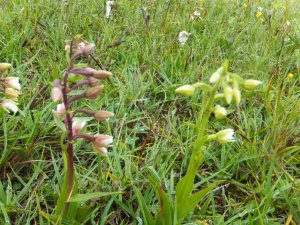
Other orchids present were Common Twayblades, Pyramidal Orchids, and a solitary Bee Orchid at the cark exit.
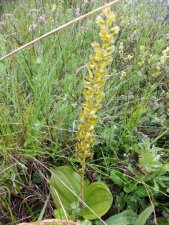 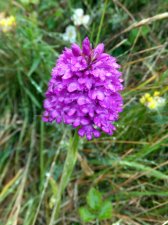 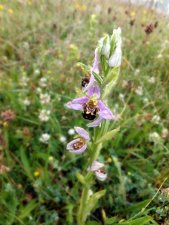
26-28th June 2015, Cotswolds Attractions.
Apart from hunting orchids during the weekend we visited few other attractions. There seems to have developed over the last few years a need to have a `flower meadow' somewhere on site to demonstrate ecological soundness. All these seem to have been created using the same seed mix, which includes Common Spotted Orchids and Pyramidal Orchids. Very nice, but are they just a fad that will get mowed down in a couple of years? Will these produce seed which will populate nearby locations? Are the Common Spotted Orchids pure bred, as they do have a range of colours, shapes and sizes. Whatever, these were seen at Whitcombe Roman Villa, Painswick Rococco Gardens, and Chedworth Roman Villa - but not Sudely Castle. The was a treat with a White Helleborine, well growing wild and passed flowering in the beech woods at Hidcote gardens; sorry, no picture.
26th June 2015, Barrow Wake
I have stopped at Barrow Wake before, but only to enjoy the view which stretches from the Severn Estuary and the Black Mountains to beyond the Malvern Hills. Today the parking area is the old former road. Working on information that Musk Orchids grew on the slopes below the car park and the grassy area behind we scoured the area, but found nothing but Common Spotted Orchids, Common Twayblades and Pyramidal Orchids. As this was during the evening we left before there was any chance of doggers arriving and tried again the next morning, but with the same results.
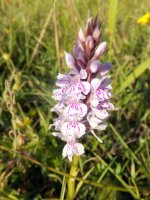 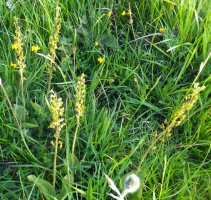 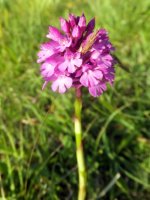
26th June 2015, Roadside orchids
On the way down to South Wales we passed a few place where flashes of purple on the road verges catch the eye. Even at normal driving speeds I think I can make a reasonable guess at the species from the colour and form.
Between Bronllys and the Brecon by-pass A470 there were well established Common Spotted Orchids. On the same road just north of the Beacons Reservoir was a patch of likely Heath Spotted Orchids. On the A465, Heads of the Valleys road, just before Hirnant was another grouping of Common Spotted Orchids. Finally, at the island joining the A4229 and B4283 near Kenfig was the unmistakable colours of Southern Marsh Orchids.
27th June 2015, Leckhampton Hill
This site was visited as Musk Orchids are reported to grow there, but like all the south Cotswolds sites this weekend proved a disappointment. We started at the car park at the old quarry at the south of the hill, where some nice intensely coloured Pyramidal Orchids can be found, before taking the steep path up. The top of the hill had fewer orchids all round. The were Common Twayblades and Common Spotted Orchids, some of which were very pale; white petals and sepals with the faintest of markings.
On our return close to dusk there were a couple of finds in the trees and bushes bordering the steep path and at the car-park entrance. Low light made photography more difficult and flash did not help much. The first finding were a small group of White Helleborines. They had finished flowering but unraveling a flower showed that it belonged to the Cephalanthera genus. It is only natural to hope that these were a previously undiscovered colony of Red Helleborines, but they were so close to the path someone else would have spotted them before now. More objectively, the base of the ovary shows no reddish colouration. Both the leaves, ovaries, and bracts rule against the Sword-leaved Helleborine. Growing nearby and at the car-park entrance were an Epipactis species, with flower spikes in bud. The leaves lying on opposite sides of the stem points away from Broad Leaved Helleborine, but distinction between Narrow-lipped Helleborine and Green-Flowered Helleborine is difficult at this stage of growth. Habitat and locatin, plus small details regarding the leaves, points to Narrow-lipped. There may be a chance to revist later in the summer.
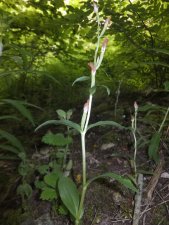 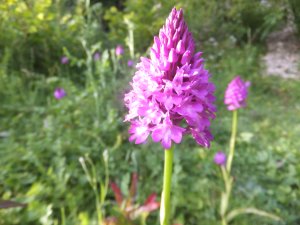 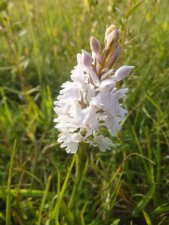 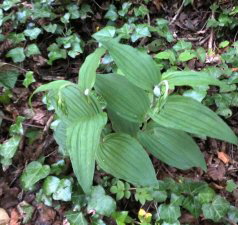
27th June 2015, Painswick Hill
This is an almost surreal place. You climb up the hill towards what was a Neolithic hill fort. You can see the 3000 year old defences surrounding the hill top. You cross over into what would would be the inner communal area and find ...... a golf course, with greens and tee-offs .... and men with questionable dress sense. The hope was to find Musk Orchids, but as ever on this trip, we find no sign of them. Could be too early. The orchid population is typical of the area with the trio of Common Spotted Orchids, Common Twayblades and Pyramidal Orchids, plus Bee Orchids and Chalk Fragrant Orchids. This latter species were identified by the lip having a central lobe larger than the side lobes and the lateral sepals deflexed at 30°. However there was a small population (picture three) with larger side lobes to the lip and horizontal sepals. This might be identified as a Marsh Fragrant in a different situation. I think this demonstrates that identifying Fragrant Orchids should not be based on a single example, and that location type is a major factor.
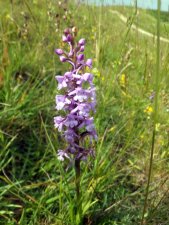 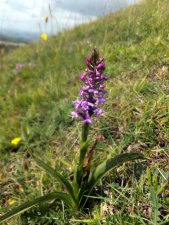 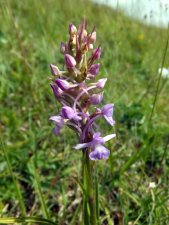
27th June 2015, Workman's Wood
In search of the Red Helleborine. Actually this site and the Red Hellborines are protected behind an 8' chicken wire and barbed wire fence. It is rather overgrown and the chances of actually spotting a Red Helleborine in flower in the middle is rather remote. `Tis said that one requires powerful binoculars, a good zoom lens, and near infinite patience. That said, being within a couple of miles from the reserve, it was worth a short detour. In the midst of the vegetation I did espy a glimpse of reddish pink, deep in the middle and using x15 zoom snapped away. Obviously it was a false alarm.
The Red Helleborine has exacting requirements, especially regarding light, and needs to be protected to survive, but I couldn't help thinking that this enclosure was more than a little overgrown; had it been tended at all this year?
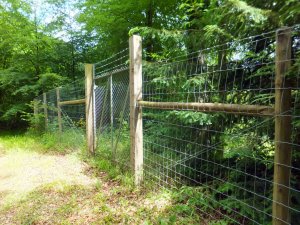 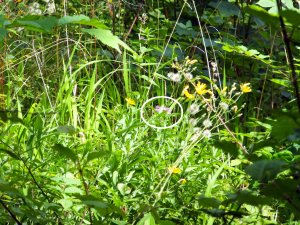 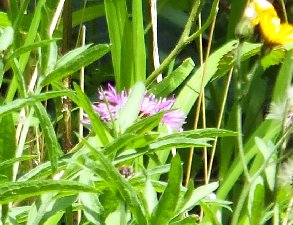
27th June 2015, near Birdlip
In search of the elusive Wasp Orchid, (Ophrys apiphera var trollyii), we only came across Common Spotted Orchids and Pyramidal Orchids. However leaving the site via a woodland path both Bird's Nest Orchid and some non-flowering Helleborines. From the spiral arrangement of the leaves these were most likely Broad-Leaved Helleborines, and not the local specialty, the Narrow-lipped Helleborines.
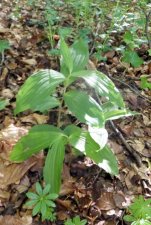 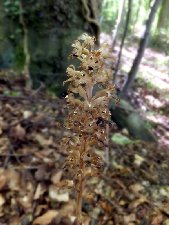
27th June 2015, Crickley Hill
This is another potential Musk Orchid site in the South Cotswolds - allegedly growing on the scarps above the old quarries. Like Barrow Wake (below) there were no Musks and only Common Spotted Orchids, Common Twayblades and Pyramidal Orchids were to be found. There were some pure white Common Spotteds though - var albiflora - note the unspotted leaf barely visible in the photo.
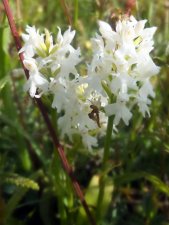
28th June 2015, Wenlock Edge
Visiting here at the end of July last year we passed above one of the many quarries and noticed that there were some orchids in the seed ripening stage and have returned to identify them. The site is basically a public footpath in the open with a bit of fenced off quarry edge. As expected the orchids turned out to be Bee and Pyramidal Orchids in small numbers. The best display was reserved for the road verge on the Much Wenlock to Craven Arms road, for the first mile and a half from Much Wenlock with many hundreds of Pyramidal Orchids
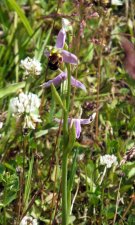
    
|
